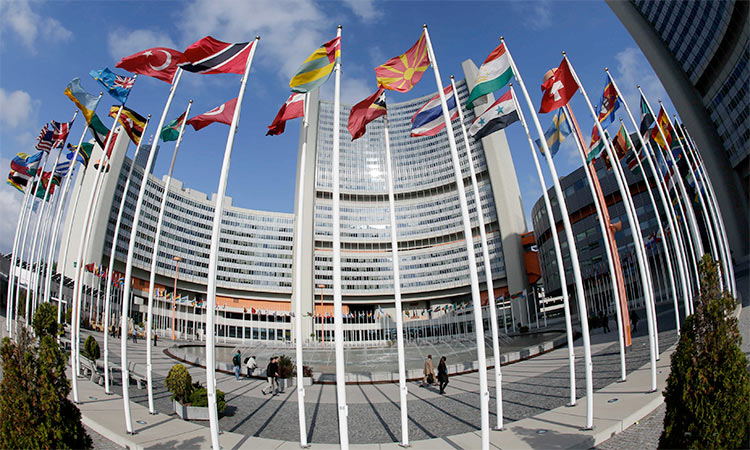In the arms race for space weaponry, Russia fires a shot across the bow

February 14, 2024
The Ukraine war demonstrated the military impact of Starlink and other space-based communications and intelligence networks. Now, Russia appears to be working on weapons aimed at disabling such systems using new space-warfare technologies
Russia’s development of space weapons technology is at the heart of the “serious national security threat” mentioned elliptically on Wednesday by Rep. Michael R. Turner (R-Ohio), chairman of the House Intelligence Committee, according to congressional sources. National security adviser Jake Sullivan plans to brief the so-called Gang of Eight congressional leaders about the Russian threat Thursday.
Although national security officials caution that the Russian capability isn’t an imminent danger to the United States, Turner’s spotlighting of Moscow’s aggressive plans could have a short-term impact on congressional approval of additional military assistance for Ukraine. Ironically, it’s the Ukraine conflict — and the role of space systems in helping Kyiv survive the initial Russian onslaught in 2022 — that likely triggered Russia to rush development of its new space tactics.
Starlink and other space systems allowed Ukraine to create an electronic battle-management system. Constellations of commercial satellites could gather information with optical, thermal and other sensors. That information could be analyzed by artificial intelligence to determine likely targets, and the targeting information could then by beamed to Ukrainian troops at the front through Starlink and other broadband connections.
Russia warned more than a year ago that it might take action against these commercial satellite providers. Konstantin Vorontsov, a senior Russian diplomat, said in a speech at the United Nations in October 2022 that the array of private satellites was “an extremely dangerous trend that goes beyond the harmless use of outer-space technologies and has become apparent during the latest developments in Ukraine.” He said this “quasi-civilian infrastructure may become a legitimate target for retaliation.”
U.S. officials didn’t provide details of Russia’s new capability. But the Russians might be planning to use directed-energy weapons or electromagnetic pulses in space that could disable commercial and military networks. Such systems could, for example, attack the exotic “mesh networks” that allow Starlink and other companies to bounce signals among their satellites before sending data back to Earth.
In 2021, Russia tested an antisatellite weapon that could shoot an orbiter out of the sky (creating a horrible debris field in the process). And Russia could, in theory, fire a series of nuclear ASATs to make space a no-go zone. But such an approach would be sloppy and self-destructive, in addition to violating a treaty banning nuclear weapons in space. Russia’s new technology appears to be something more sophisticated.
The United States has an array of intelligence and military systems in space with what officials often describe as “exquisite” capabilities. But these amazing sensors and other technologies are carried by a small network of satellites that offer a handful of “fat, juicy targets,” as Gen. John E. Hyten, former vice chairman of the Joint Chiefs of Staff, put it in 2017.
“We have to build a more resilient architecture,” with more small satellites, Gen. John W. “Jay” Raymond, then head of the Space Force, told me in 2021. As things have evolved, it has been commercial companies such as Starlink, which has more than 5,000 satellites, that have developed the hard-to-target architecture. That’s what probably worries Russia.
Starlink, owned by Elon Musk’s SpaceX, was a game changer in the opening weeks of the war in Ukraine. The satellites provided broadband internet signals that, combined with commercial imagery satellites, helped Ukraine identify and target Russian attacks. In the first hours of the war. a Russian cyberattack briefly disabled a smaller U.S. broadband system operated by a company called Viasat. But that network rebounded, and it was joined by a galaxy of other space systems.
Starlink terminals gave Ukraine the connectivity to fight a 21st-century “algorithm war.” Russia tried to jam and spoof the data coming from space, but Starlink engineers found ingenious ways to keep the data flowing. On Feb. 26, 2022, two days after the Russian invasion, Musk tweeted: “Starlink service is now active in Ukraine. More terminals en route.”
Musk doubled down that May, posting: “Starlink has resisted Russian cyberwar jamming & hacking attempts so far, but they’re ramping up their efforts.” But he became anxious about Starlink’s role and threatened to withhold the vital service unless he got paid for it, before deciding in October 2022, “The hell with it … we’ll just keep funding Ukraine govt for free.
Musk’s growing concern about Starlink’s role in the war was described by Walter Isaacson in his recent biography. The mega-billionaire balked at Ukraine’s request to provide coverage for operations against Russian-occupied Crimea. Musk explained to Isaacson: “Starlink was not meant to be involved in wars. It was so people can watch Netflix and chill and get online for school and do good peaceful things, not drone strikes.”
Russia, it seems, is looking for new ways to challenge the United States’ space supremacy. But given the ingenuity of U.S. engineers in helping friends and evading enemies, it’s a safe bet that the cycle of punch and counterpunch in space is just beginning.

Opinion by David Ignatius
Republican House intelligence chair, Mike Turner, says Biden officials should declassify information about threat, while House speaker Mike Johnson says there was no need for panic
Julian Borger in Washington
The head of the House intelligence committee, Mike Turner, has called for the Biden administration to declassify information on what he called a “serious national security threat”, which was later reported to involve Russian plans to deploy nuclear weapons in space.
In his statement, Turner, an Ohio Republican, gave no details about the supposed security threat.
Talking to reporters at the White House later on Wednesday, the national security adviser, Jake Sullivan, expressed surprise at Turner’s statement saying he was due to meet the “gang of eight” (congressional leaders with special security clearance for classified briefings) on Thursday. But Sullivan did not give any details of the planned meeting.
ABC News and the New York Times cited unnamed sources as saying that the security threat Turner was referring to involved Russia’s potential deployment of a nuclear anti-satellite weapon in space. The New York Times said US allies had also been briefed on the intelligence, which was not deemed to represent an urgent threat, as the alleged Russian capability was still in development.

Wars and climate crisis keep Doomsday Clock at 90 seconds to midnight
It is not clear whether the new intelligence alert is connected to a Russian launch on 9 February of a Soyuz rocket carrying a classified defence ministry payload.
“Russia has been conducting several experiments with manoeuvring satellites that might be designed to sabotage other satellites,” Hans Kristensen, director of the nuclear information project at the Federation of American Scientists, said. He pointed out that any such deployment of nuclear weapons in space would violate the 1967 Outer Space Treaty, to which Moscow is a signatory.
“The issue is not so much about an increased nuclear weapons threat per se but that it would increase the threat against other countries’ space-based nuclear command and control assets. It would be highly destabilising.”
Pavel Podvig, an expert on Russian nuclear forces, said: “I am very skeptical (to put it mildly). Unfortunately, it’s impossible to categorically rule out anything these days. But still, I don’t think it’s plausible.”
Kristensen suggested that a Russian threat to put nuclear weapons in space, thus destroying yet another non-proliferation treaty, could be the latest in a long line of Vladimir Putin’s moves designed to add to pressure on the US and its allies to end their military support for Ukraine.
Daryl Kimball, the head of the Arms Control Association, said a nuclear anti-satellite weapon made little practical sense.
“You don’t need a nuclear weapon to blow up a satellite in orbit. All objects in space are so delicate, that you can do something with much less than a nuclear detonation,” Kimball said. “Plus, it’s completely illegal.”
The House speaker, Mike Johnson, said there was no need for panic over the alleged, unnamed threat. He said he was not allowed to discuss classified information but told reporters: “We just want to assure everyone steady hands are at the wheel. We’re working on it and there’s no need for alarm.”







